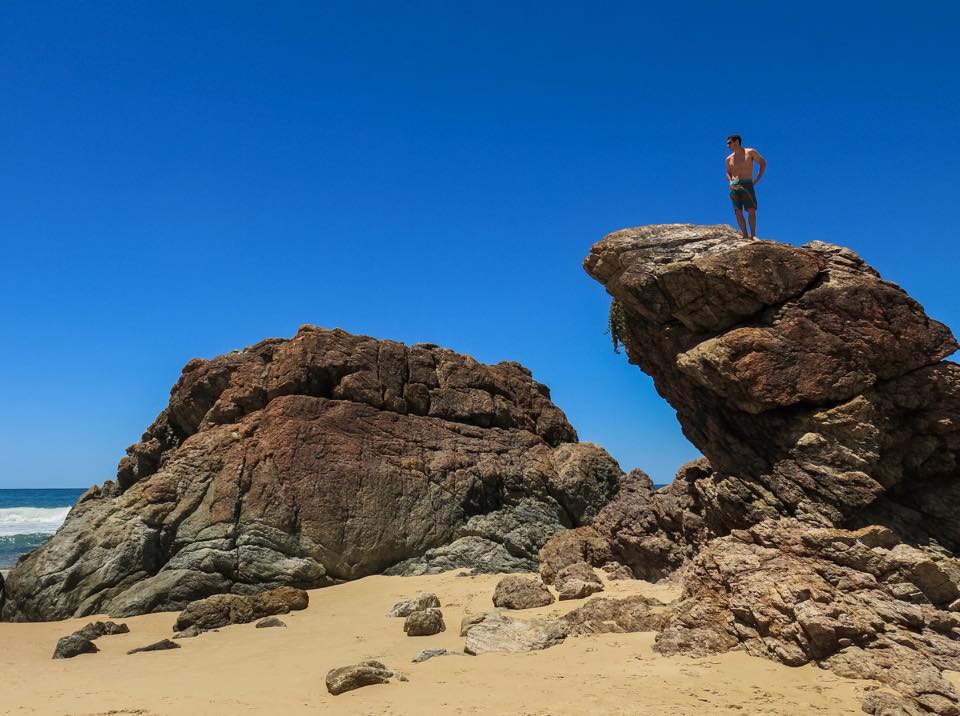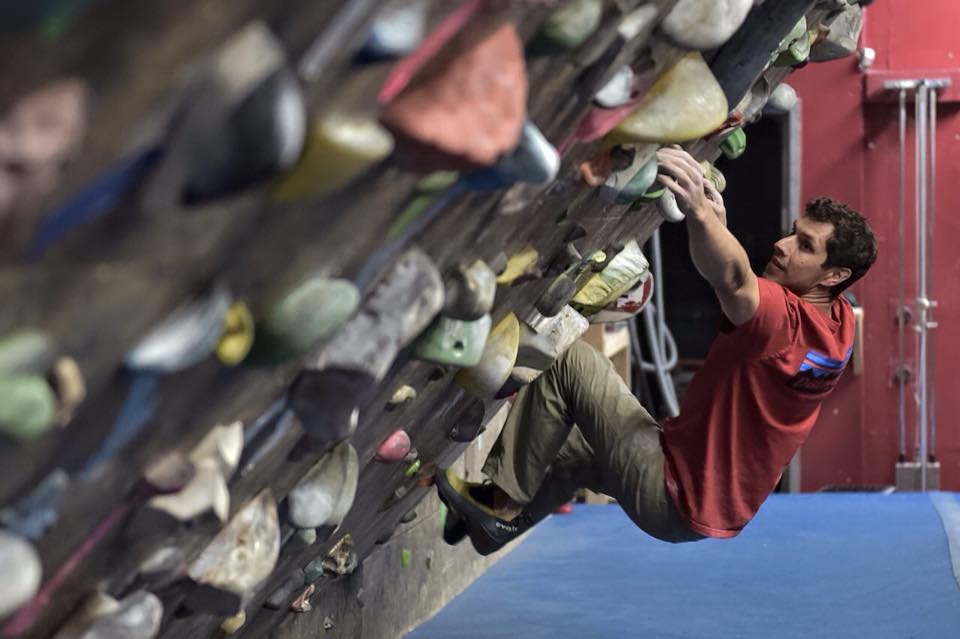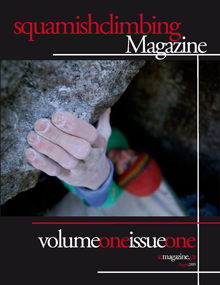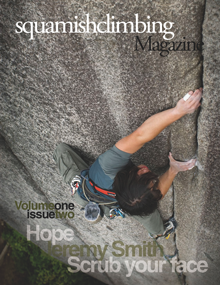Over the past few years, Jamie Finlayson has become a mainstay in the Squamish climbing scene. Not only is he a Director on the Squamish Access Society, he is also a local business owner and full-time climber. Jamie had a fantastic run this year, including an ascent of Superman (5.14c) on the Big Show in Chek Canyon. Recently, Jamie underwent back surgery after years of pain and discomfort. Squamish Climbing Magazine had a chance to catch up with him while he was down under and here is what he said.

Jamie Finlayson smiling at the camera.
Hey Jamie, how are things going?
Things are going well. I just got back from Australia!
How did your trip go?
Australia was great. Lots of time to heal and see the amazing country. We spent a lot of time sight seeing, hiking, and hanging out in the ocean. I even found a few great little boulders on the beach that I had to climb. Australia is an amazing country and I was sad to leave but all holidays must come to an end. Now back to work!
I am feeling very good now and I have resumed my training regime. I still have a lot of work to do but I am feeling very positive and very motivated to get back into peak shape for the spring!
To give our readers a little bit of background, can you tell us how you got into climbing?
I started climbing in 1995. When I was younger I was a competitive alpine ski racer. While summer training in Mt Hood, Oregon my ski coach took a group of us climbing one day after skiing. I was hooked instantly! On our day off he took us to Smith Rock, which was awesome. When I got home from the ski trip I bought a rope, some carabiners, a harness, and some shoes. I grew up in Whistler and there was a crag about a block from my house, Nordic Bluffs. I would go climbing everyday possible and was essential self taught.
Over the past number of years, you have started to climb harder and harder. Can you tell us what led to your progression?
I feel like I have been consistently progressing since about 2007. That is when my ski career finishing and I devote a bunch of time to climbing. Since then I have been able to tick about a letter grade higher a year. Over the past couple of years I have really become more devoted to training and this has really helped me push the grades.
Has your ‘ski race’ background helped at all with your progress in climbing?
I grew up as a ski racer and was on the Canadian Alpine Ski Team. It was a great experience and I got to travel the world and race in some amazing places. Skiing taught me many great life lessons at an early age such as: time management, self confidence, perseverance, dealing with success and failure, and most importantly hard work. Working hard and dealing with pain is essential if you want to get better and this translates directly to any sport or activity.
Last year you accomplished a number of your climbing goals. Can you tell us a bit about your experience here?
This past season was essentially the culmination of a two year training block. I trained and climbed basically four or five days a week for two years. The result was me ticking a lot of goals. Each year I try to set myself a few goals that are hopefully manageable, not too fair away from reality. If I achieve them all great, if not I need to get stronger! The past two seasons I managed to send two 14a’s, three 14b’s, and two 14c’s.

Jamie trying hard on the big show. Photo by Bill Hawley ©
Did you know that it would take two years to accomplish these goals?
I never really set out with the intent of sending all of the routes that I have completed. I take each route or sometime two routes at a time and work them. Once those are done I move on to the next. Over the past two years I really started to focus in on my training and be a little more focused on specific weaknesses that were holding me back.
Is there any training techniques that you can attribute to the growth in your climbing?
There are some many different aspects to training for climbing. For me, I attribute my growth to hard work and tenacity. I climb a lot which is a great way to get better. If you want to get better at tennis you have to play tennis a lot. It is pretty simple. Sure I do some specific training such as campus training and hang boarding, but for me I just love to climb and it has been the tool for me to get better.
Is that a dig on my tennis skills?
(a big grin…then silence)
How many days a week is a lot for you and how many fingerboard sessions did you add into your training?
In the spring, summer, and fall I try and climb five days a week outside (weather depending). I will do a finger board session two times a week on day that were lighter. When climbing a lot, I find it very important to vary the intensity to avoid injury. Some days are light and I will only give a certain climb a few goes and others I will try and get more mileage. In the winter, when I am in the gym most of the time, I still try and climb 5 days a week. I will also vary the intensive and activity to avoid injury. I will usually boulder for two of those days, campus one day, easy traversing for one day, and hard traversing one day. Nothing is really set in stone but I try to keep things varied.
How has the process been projecting ‘Dreamcatcher’ and what can you tell us about the route?
Dreamcatcher is the ultimate challenge for me and I love it! The climb is amazing and extremely complex. It is definitely the next step for me. Whenever I try and break into the next grade it takes a bunch of work and this route will take even more work. When projecting a route I try and stay positive throughout the process and find success in failure. Breaking the route down in small manageable sections and then trying to link those sections together, and so on. I feel that is it possible and I will be able to do the route it is just a matter of time and perseverance. I have been able to do the route in two sections, one hang, just one large section to go!

Jamie on Dreamcatcher. Photo by Bill Hawley ©
Is it mentally hard to find the progress? Do you use any mental techniques to stay psyched?
I am a fairly patience person and I rarely get frustrated with lack of progress when projecting. I figure that it will happen when it happens. For me to send a hard route a lot of factors have to be right, the weather, my skin, and my fatigue level. I try and remain positive throughout the process and try to take something positive out of each day no matter how bad that given day might have been. This really keeps the session productive rather than destructive. The mind is a powerful tool, if you believe you can do something and you can do all of the moves, then it is just a matter of time until it all comes together.
Often when you are out climbing, you continue to try to repeat your hardest sends at the end of the climbing day. Do you care if you repeat these routes at the end of the day or do you just see it as training?
It is always nice to send routes that I have already sent before and yes I do sometimes try and repeat them either for warm up or for cool down. Fore instance, climbing on the steep Big Show wall in the Chek Canyon requires a specific fitness that is hard to replicate anyways else in Squamish. Therefore, I find it very valuable to climb a lot on that wall if I am trying to send a route on the wall. If I send any of those warm up or cool down routes great, if not no worries.
You don’t get the opportunity to climb outside Squamish very often. Is there a reason for this and do you dream of any particular routes beyond the Canadian borders?
I normally get one trip a year to climb some place other than BC. I would love to get to travel and climb in more places around the globe but I have a busy work schedule that does not allow me to leave the Sea to Sky area often. I would love to travel and climb in Spain and hopefully will have the time in the next year or so to get over there!
Recently, you underwent back-surgery for the degeneration of your spine? Can you tell us a bit about what caused this and how your recovery is going at the current moment?
My back has been a problem for me for a long time. I suffer from a genetic disorder called ankylosing spondylitis, which is essentially arthritis of the spine. Over the past few years I have been struggling with lower back issues and recently had some major surgery done. I had a disc removed and two vertebrae fused together with some rods and screws. I am currently about 10 weeks post op and feeling pretty good.
Can you describe some of the back problems prior to the surgery and how it is feeling now?
Prior to surgery I had a lot of nerve pain. Both of my legs were numb off and on for a couple of years. It got progressively worse until I could barley walk my dogs around the block. I also had a lot of low back pain. Now after the surgery the numbness is completely gone and the low back pain is getting better. I am still suffering a bit from the aftermath of the surgery but each day gets a bit better. I have a sweet 10 inch scar along my lower spine. Overall the surgery was a huge success and I am super happy about that!
In light of the surgery, do you have any goals moving forward?
Well my first goal is to get back into shape after a few months off. I have had a hand full of sessions in the gym since the surgery and I actually feel better than I had expected! Depending on how the back feels I would like to get back at Dreamcatcher and start to seriously try The Cobra Crack.

Jamie on his first ascent of the year (and post surgery!).
What draws you to the cobra crack?
I have spent about 5 days on the cobra a few years ago and made some great links fairly quickly. I have been meaning to go back ever since. It is such an amazing line and I would love to be good enough to climb it. It will be yet another great challenge!
Recently I saw that you appeared in the new Patagonia store in Vancouver, How did this come about?
Over the past few years I have been fortunate enough to be supported by a few different companies, most recently Patagonia. They approached me to do a story on my quest to conquer Dreamcatcher for the opening of the new store in Vancouver.
You have gathered some great sponsors over the last few years. Does this put any pressure on you to perform?
Yes, I do feel pressure but not from the sponsors themselves. I feel pressure from my peers and from within. There is a definite stigma about being sponsored for climbing. People judge you and if you are not on peak form then people start to grumble. But I feel like it is a honour to represent these amazing companies and I am humbled to even have been considered.
How has the scene changed there since you first started climbing?
I have lived in Squamish itself for 6 years now but in the Sea to Sky my entire life. The area has changed a lot over the years. Climbing over the past 5 years has exploded and there are more and more people taking up the sport. There are so many dedicated route developers in Squamish that have been going great guns to provide an increasing amount of climbable terrain. With this increase of popularity comes many other challenges and it is up to everyone to be mindful of the surroundings and protect our climbing for future generations. I feel it is important to get involved and help support the local access societies to keep our climbing accessible to all.
Obviously with increased people, the forest and other parts of Squamish are taking a bit of a beating. Is there any one thing you think is important for people to do in order to preserve the climbing areas in squamish?
Be mindful for your surroundings and leave no trace.
Besides climbing, you own a successful home construction business. Can you tell us a bit about how this came to be?
I am co-owner of Coastal Mountain Custom Homes Ltd. We specialize in custom green renovations and new homes. We have been very fortunate since we started the company in 2010 and have grown every year since. We currently employ 10 people and have projects from Whistler to West Vancouver. It is a challenge to manage my time between my extremely busy work schedule, my climbing, and home life!
Thanks again for your time Jamie. Squamish Climbing Magazine wishes you a speedy recovery and cannot wait to see you back on your projects this spring.

Jamie back home in the Co-op. Photo courtesy of Tim Emmett ©
Jamie is supported by Petzl, Evolv, Patagonia, and Go Pro.












